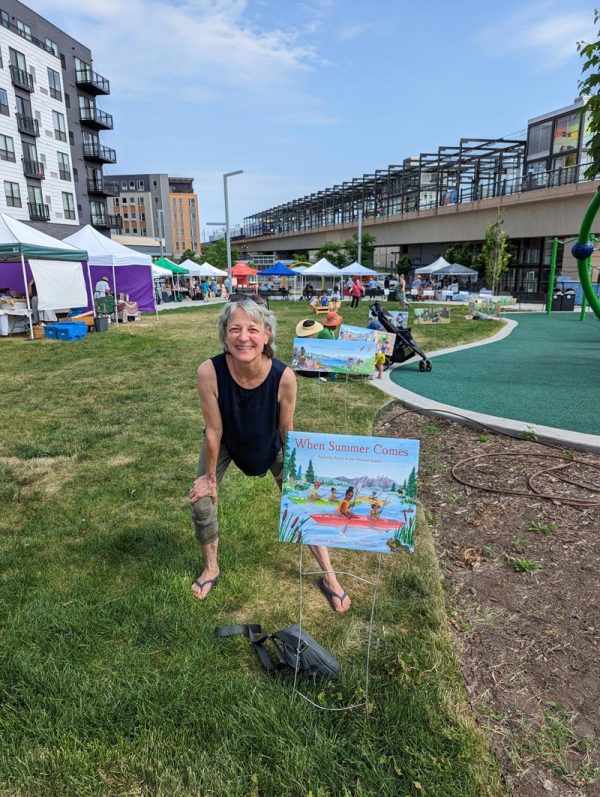“When summer comes, and the sky soars blue above us, and the days stretch long and warm before us,” begins Aimée Bissonette’s new picture book, When Summer Comes: Exploring Nature in Our Warmest Season (Little Bigfoot, 2023). The title is a poetic celebration of the wonders, big and small, that can be found in the outdoor world, whether at a city picnic or on a camping trip to the wilderness. The book joins the already popular When Winter Comes: Discovering Wildlife in Our Snowy Woods (Little Bigfoot, 2020). The next title in the series is When Fall Comes: Connecting with Nature When the Days Grow Shorter (Little Bigfoot, 2023), which will come out September 5. Each one of the titles—all illustrated by Erin Hourigan—invites readers to join in seasonal adventures as a different human family joyfully explores the nooks and crannies of the natural world while a cast of intriguing creatures carry out the tasks demanded by each season. Along with opportunities to compare/contrast the four seasons, the series also provides a great way to incorporate the natural world into classrooms—a goal endorsed by a 2023 article in Psychology Today that states, “For the health, well-being, and resilience of individual children and the planet, nature education should be woven into the curriculum for every child.”

Here, Bissonette talks with Lisa Bullard about her love of writing about nature, the “everyday heroes” who have inspired several of her books, and her best advice for anyone who dreams about creating their own children’s book someday.
All the titles in your series encourage young readers to deeply engage with the natural world around them. Can you talk about why that’s such an important focus for your writing? In what ways has this focus been inspired by your own life or your own experiences as a child?
I am a self-proclaimed nature nerd. Getting outside is physically freeing but also feeds creativity. I have six siblings, and life indoors could be a little cramped and chaotic when I was growing up. Thank goodness my folks believed in the benefits of exploring the outdoor world, both as a family and on my own. We camped in the mountains and the eastern Oregon deserts; we waterskied and downhill skied in upstate New York; and we combed beaches and had snowball fights. So much of my young life revolved around nature, and my husband and I replicated those experiences with our own kids. The simplest things in nature can be awe-inspiring. Kids see this and react to this, so writing nature books for them is a joy.


The simplest things in nature can be awe-inspiring. Kids see this and react to this, so writing nature books for them is a joy.”
Along with the natural world, another focus of your published works is what your website describes as “everyday heroes”—a great example being your picture book biography Headstrong Hallie! The Story of Hallie Morse Daggett, the First Female “Fire Guard” (Sleeping Bear Press, 2021). What does the phrase “everyday heroes” mean to you? Why are you drawn to write about little-known history makers?
I have always been a fan of “underdog” stories—stories about people who work hard, sometimes with little recognition, and accomplish more than perhaps even they expect. There are so many stories from history like this, particularly stories about women and people of color that may have been overlooked in the past. Young readers are familiar with a lot of important historical figures (e.g., presidents, war heroes, groundbreaking scientists) and they should be. But I strive to introduce them to lesser-known people, the “everyday heroes” who worked day in and day out doing jobs that were essential to their neighbors and communities. Harriet Colfax, our nation’s longest-serving lighthouse keeper, was one such person; I feature her in Miss Colfax’s Light (Sleeping Bear Press, 2016). Hallie Morse Daggett, whom you mention, is another. In choosing a hero to profile, I look for someone who has had to face challenges and persevere, just as so many kids have to do today. I want to present role models for young readers. I also want to dispel some of the negative views our society has about women’s abilities and aging.

In choosing a hero to profile, I look for someone who has had to face challenges and persevere, just as so many kids have to do today.”
When I was thinking about what might be the underlying concept that links all your books, I realized that perhaps it is the notion of persisting despite obstacles. You’ve already talked about that regarding the everyday heroes you choose to feature in your biographies, but I believe that it can also apply to your books about the natural world, since nature is in a constant cycle of death, rebirth, and new life. Fall and then winter are always followed by spring and then summer. Does that resonate with you?
Oh, I like that! Persisting despite obstacles is definitely a theme in my books. It’s apparent in the biographies I have written, but also in many of my nature books, including Dragonfly (Albert Whitman, 2020) and The Second Life of Trees (Albert Whitman, 2021). Dragonflies live dangerous, adventure-filled lives and provide for next season’s dragonflies before their own short lives end. Trees bestow gifts on us while they are alive and long after they die. They truly are nature’s “everyday heroes.”

With your focus on the real world of wildlife—and real people’s lives—you must do a lot of research. Can you talk about that process? What part of research do you enjoy the most?
I love research. I enjoy gaining expertise about a topic or time in history. I love collaborating with illustrators to ensure that young readers learn from the art in our books, too. Much of my research involves reading books and conducting interviews. My favorite thing, though, is to go to the nature center, park, museum, or historical site where my story takes place so I can see, smell, and hear firsthand all the things I should be incorporating in my books. For instance, while researching Miss Colfax’s Light, I visited the Michigan City Lighthouse where Harriet Colfax worked. The docents at the museum were amazingly helpful. One of them had even transcribed Harriet’s decades-long lighthouse keeper’s log. Reading that transcript helped me get a true feel for Harriet and her day-to-day life. It also allowed me to incorporate Harriet’s own words into my text. What a gift!
What are some tips you can share with young people who need to do research for their own writing assignments?
I encourage students to have fun with their research and to look for unexpected sources of information—something beyond books and the internet.
Do you have an activity or two to share with educators and librarians who want to read your titles with their students?
Absolutely. Tying activities and books together is the way to go! If you follow me on social media, you’ll see that the majority of my posts provide links to activities for educators, parents, and families. A recent post suggested tying Miss Colfax’s Light with real-life lighthouse road trips and activities like those described here. Another provided links to a PBS Kids list of ways to celebrate Earth Day with kids and a “Tree Education Hub.” The activities on these sites pair well with several of my nature-inspired books. By the way, when it comes to pairing activities with nature books, the sky is really the limit. Just think “more green, less screen” and get outdoors!

When it comes to pairing activities with nature books, the sky is really the limit. Just think ‘more green, less screen’ and get outdoors!”
Your website mentions that next to writing children’s books, your second favorite job was when you worked as a lawyer who helped other authors and illustrators get their books published. A good number of the educators and librarians who work hard to put books into the hands of young people also share that dream of getting a book of their own published someday. What’s your best advice for them?
Don’t dream it, do it. There is a great deal to learn about the children’s publishing world, but the real work comes with reading, writing, and revising (just what we tell our students, right?). Read lots of children’s books. Look at structure as well as text. Be mindful of how illustrations support the text in picture books and often make words nonessential. Be playful. Take one idea and write it in different ways: as a poem, as nonfiction, with humor, with varying word counts. Go to conferences and workshops where you can learn about craft and the writing business. That’s a great way to meet new friends who will share their experiences, and to connect with editors and agents. As I said, there is a lot to learn. It’s a continuing journey and takes time, which means there’s no better time to start than now.
[Getting your own children’s book published is] a continuing journey and takes time, which means there’s no better time to start than now.”
What would you like to tell your readers about your forthcoming books?
Working with the team at Little Bigfoot and illustrator Erin Hourigan on our seasonal picture book series has been a dream come true. When Spring Comes will soon be in the works, and I’m hoping we also do board book versions for all the books in the series, as we did for When Winter Comes. I’m traveling a lot this summer for book-related events and will be a guest author at the Minnesota State Fair’s Alphabet Forest. As for current works in progress, I’ve got two I’m particularly excited about—both nonfiction. Keep your fingers crossed that a publisher loves those as much as I do!

What are the best ways for readers to connect with you or to follow you on social media?
I am on Twitter, Facebook, and Instagram. My “handle” for all three is my name. I love to hear from educators and librarians and other writers, so follow me, and I’ll follow back. Social media is a great way to share tips and resources.
Is there anything else you’d like to add?
I want to say thank you to all of you who work with and on behalf of young readers. As you know, reading is life-changing. It introduces us to people and worlds we wouldn’t otherwise know. It fuels our creativity. You open doors for each and every student you help learn to read. You are my “everyday heroes!”






